Numerical Study of the Reinforcing Pads Geometry of Pressure Vessels
Abstract
1. Introduction
- stress distribution in the nozzle-shell intersection,
- reduction of the shell thickness of the pressure vessel.
2. Materials and Methods
- Case 1—deal load, working pressure 2.5 MPa with temperature equal to 150 °C and loading of nozzles,
- Case 2—deal load, test pressure 3.9 MPa, and loading of nozzles.
3. Results and Discussion
3.1. Case 1—Working Pressure with Elevated Temperature
3.2. Case 2—Test Pressure
4. Conclusions
- The use of the elliptical reinforcing pads leads to a significant decrease in the thickness of the shell. In the presented example, the decrease in thickness is equal to 10 mm (28 mm to 18 mm, 36%), and the total mass savings are equal to 1.85 t (6.11 t to 4.26 t, 30%).
- The abovementioned savings also lead to a decrease in the carbon footprint during the production of the vessel.
- The concentration of the maximal von Mises stress appears in the nozzle-shell connection, so the use of the reinforcing pads is recommended.
- The coupled thermal-displacement model in Abaqus software can be an effective tool to analyze pressure vessels at elevated temperatures.
- The introduced efficiency ratio grows with the growing nozzle diameter in the variant with the reinforcing pads, but the von Mises stress is lower than the ultimate stress. The ratio reaches its highest value in the largest nozzle under the first load combination and without reinforcing pads (0.735). The use of the reinforcing pads leads to an almost stable value of the efficiency ratio, regardless of the diameter of the nozzle. The factor can be useful in engineering practice to provide quick information on the effect caused by the reinforcing pads.
Author Contributions
Funding
Institutional Review Board Statement
Informed Consent Statement
Data Availability Statement
Acknowledgments
Conflicts of Interest
Abbreviations
| FEM | Finite element method |
| SCF | Stress concentration factor |
| CNC | Computer numerical control |
References
- Detman, R. A Review of Piping and Pressure Vessel Code Design Criteria; Technical Report 217; Braun (C. F.) and Co.: Alhambra, CA, USA, 1969. [Google Scholar]
- Patil, A.D.; Jadhav, M.M. Analysis of Pressure Vessel: A Review. Int. J. Innov. Res. Sci. Technol. 2017, 3, 153–157. [Google Scholar]
- Toudehdehghan, A.; Hong, T.W. A critical review and analysis of pressure vessel structures. Mater. Sci. Eng. 2019, 469, 012009. [Google Scholar] [CrossRef]
- Singh, A.V. Stresses in Welded Pad Reinforced Nozzle in Spherical and Ellipsoidal Pressure Vessel. In Computational Mechanics ’88; Alturi, S.N., Ed.; Springer: Berlin/Heidelberg, Germany, 1988; pp. 32–33. [Google Scholar]
- Sang, Z.F.; Xue, L.P.; Lin, Y.J.; Widera, G.E.O. Limit and burst pressures for a cylindrical shell intersection with intermediate diameter ratio. Int. J. Press. Vessel. Pip. 2002, 79, 341–349. [Google Scholar] [CrossRef]
- Miranda, J.R.; de Souza Werneck, H.; Cimini, C.A., Jr. Stress analysis on vessel/nozzle intersections with/without pad reinforcement for cylindrical pressure vessels. In Proceedings of the COBEM 2007, Brasilia, Brazil, 5–9 November 2007. [Google Scholar]
- Fang, J.; Tang, Q.H.; Sang, Z.F. A comparative study of usefulness for pad reinforcement in cylindrical vessels under external load on nozzle. Int. J. Press. Vessel. Pip. 2009, 86, 273–279. [Google Scholar] [CrossRef]
- Jamadar, I.M.; Patil, S.M.; Chavan, S.S.; Pawar, G.B.; Rakate, G.N. Thickness optimization of inclined pressure vessel using non linear finite element analysis using design by analysis approach. Int. J. Mech. Eng. Technol. 2012, 3, 682–689. [Google Scholar]
- Maghrabi, S.H.S.; Mulkutkar, M.M.; Shetty, K.; Aquil, M. Elastic Behavior of Cylindrical Vessels with Lateral Nozzle under internal pressure. Int. J. Eng. Res. Appl. 2012, 2, 1029–1034. [Google Scholar]
- Heng, L.; Park, J.H.; Wang, R.; Kim, M.S.; Yang, G.E.; Mun, S.D. Design and Analysis of Pressure Vessel According to Internal Design Pressure and Temperature Using FEM. In Proceedings of the Second International Conference on Mechanics, Materials and Structural Engineering (ICMMSE 2017), Beijing, China, 14–16 April 2017. [Google Scholar] [CrossRef]
- Balac, M.; Grbovic, A.; Petrovic, A.; Popovic, V. FEM analysis of pressure vessel with an investigation of crack growth on cylindrical surface. Maint. Reliab. 2018, 20, 378–386. [Google Scholar] [CrossRef]
- Jain, R.R.; Kanase, G.S.; Babel, G.A.; Dalvi, S.S.; Pujari, B.R. Finite Element Analysis of a Pressure Vessel and Effect of Reinforcement Pad. In Proceedings of the 7th National conference on Recent Developments in Mechanical Engineering RDME-2018, Pune, India, 23–24 March 2018. [Google Scholar]
- Barjod, B.V.; Shah, R. Analysis and Optimization of Stress on Horizontal Pressure Vessel by Varying Opening Angle and Location. Int. J. Recent. Technol. Mech. Electr. Eng. 2018, 5, 44–51. [Google Scholar]
- Abdalla, H.F. Generation of interaction diagrams of pad-reinforced and non-padded vessel/nozzle structures via employing various plastic collapse techniques. Int. J. Press. Vessel. Pip. 2021, 193, 104485. [Google Scholar] [CrossRef]
- Salins, S.S.; Mohan, M.; Stephen, C. Finite Element Investigation on the Performance of Pressure Vessel Subjected to Structural Load. Ann. Chim. Sci. Mater. 2021, 45, 201–205. [Google Scholar] [CrossRef]
- Pany, C. Investigation of Circular, Elliptical and Obround Shaped Vessels by Finite Element Method (FEM) Analysis under Internal Pressure Loading. J. Sci. Technol. Eng. Res. 2022, 3, 24–31. [Google Scholar] [CrossRef]
- Rapeta, S.R.; Denduluri, A.T.; Dunna, S.V.; Prashada, H.C.; Kuncha, S.C. Design and Analysis of Reinforcement Pad of Nozzle Junction in Pressure Vessel. Int. Adv. Res. J. Sci. Eng. Technol. 2022, 9, 300–307. [Google Scholar]
- Biradar, R.S. Finite Element Modelling and Analysis of Pressure Vessel. Int. J. Res. Appl. Sci. Eng. Technol. 2022, 10, 910–914. [Google Scholar] [CrossRef]
- Stikvoort, W. Effectiveness of reinforcement plates pertaining to pressure equipment. Am. J. Eng. Res. 2021, 10, 127–146. [Google Scholar]
- Paul, P.R.; Chowdary, V.L. Design and Static Analysis of Different Pressure Vessels and Materials Using FEM Method. Int. J. Adv. Sci. Res. 2020, 5, 93–99. [Google Scholar]
- Hazizi, K.; Ghaleeh, M. Design and Analysis of a Typical Vertical Pressure Vessel using ASME Code and FEA Technique. Designs 2023, 7, 78. [Google Scholar] [CrossRef]
- Reuss, P. Optimization and Value Analysis of a Pressure Vessel Shell. Period. Polytech. Ser. Mech. Eng. 1994, 38, 165–177. [Google Scholar]
- Carbonari, R.C.; Munoz-Rojas, P.A.; Andrade, E.Q.; Paulino, G.H.; Nishimoto, K.; Silva, E.C.N. Design of pressure vessels using shape optimization: An integrated approach. Int. J. Press. Vessel. Pip. 2021, 88, 198–212. [Google Scholar] [CrossRef]
- Nasseri, S.H.; Alizadeh, Z.; Taleshian, F. Optimized Solution of Pressure Vessel Design Using Geometric Programming. J. Math. Comput. Sci. 2012, 4, 344–349. [Google Scholar] [CrossRef]
- Gupta, S.R.; Desai, A. Optimize Nozzle Location for Minimization of Stress in Pressure Vessel. Int. J. Innov. Res. Sci. Technol. 2014, 1, 64–72. [Google Scholar]
- Hassan, S.; Kumar, K.; Deva Raj, C.; Sridhar, K. Design and Optimisation of Pressure Vessel Using Metaheuristic Approach. Appl. Mech. Mater. 2014, 465, 401–406. [Google Scholar] [CrossRef]
- Ke, X.; Zhang, Y.; Li, Y.; Du, T. Solving Design of Pressure Vessel Engineering Problem Using a Fruit Fly Optimization Algorithm. Int. J. Simul. Syst. Sci. Technol. 2016, 17, 5.1–5.7. [Google Scholar] [CrossRef]
- Widiharso, H.S.; Tauviqirrahman, M.; Jamari, M.J. Thickness Optimization of Pressure Vessel for Minimum Weight using Finite Element Method (FEM). Int. J. Eng. Technol. 2016, 8, 2676–2682. [Google Scholar] [CrossRef]
- Woldemichael, D.E.; Woldeyohannes, A.D. Optimization of Pressure Vessel Design Using pyOpt. ARPN J. Eng. Appl. Sci. 2016, 11, 14264–14268. [Google Scholar]
- NishidharBabu, M.L.; Deva Raj, C.; Krishna, B.M.; Kiran, Y.; Rao, P.M. Design and Optimization of Pressure Vessel using Real Coded Genetic Algorithm. Int. J. Sci. Eng. Res. 2017, 8, 1409–1415. [Google Scholar]
- Imran, M.; Shi, D.; Tong, L.; Waqas, H.M.; Muhammad, R.; Uddin, M.; Khan, A. Design Optimization and Non-Linear Buckling Analysis of Spherical Composite Submersible Pressure Hull. Materials 2020, 13, 2439. [Google Scholar] [CrossRef] [PubMed]
- Szybiński, B.; Romanowicz, P.J. Optimization of Flat Ends in Pressure Vessels. Materials 2019, 12, 4194. [Google Scholar] [CrossRef]
- Romanowicz, P.J.; Szybiński, B. Determination of Optimal Flat-End Head Geometries for Pressure Vessels Based on Numerical and Experimental Approaches. Materials 2021, 14, 2520. [Google Scholar] [CrossRef]
- Faisal, J.M.; Patel, B.C.; Jamnu, M.A.; Mistry, R.A. Stress Analysis of Different Reinforcement PAD for Nozzle Opening in Pressure Vessel. Int. J. Sci. Technol. Eng. 2016, 2, 354–360. [Google Scholar]
- Ismail, A.E.; Ghazali, M.Z.M. The Development of Reinforcement Pad Design for Pressure Vessel. Int. J. Rec. Technol. Eng. 2020, 8, 267–269. [Google Scholar] [CrossRef]
- Yuan, J.; Ma, F.; Zhang, M.; Shen, K.; Tang, J. The Time-Domain Design Stress Method for Fatigue Analysis of the Reactor Pressure Vessel in Floating Nuclear Power Plants. J. Mar. Sci. Eng. 2025, 13, 235. [Google Scholar] [CrossRef]
- Ma, F.; Li, H.; Zhang, M.; Qu, X. A Quasi Time-Domain Method for Fatigue Analysis of Reactor Pressure Vessels in Floating Nuclear Power Plants in Marine Environments. J. Mar. Sci. Eng. 2024, 12, 2085. [Google Scholar] [CrossRef]
- Bozkurt, M.; Nash, D. Stress linearization application of oblique nozzles with welded pad reinforcement in cylindrical pressure vessels. J. Mech. Eng. Sci. 2023, 238, 1642–1654. [Google Scholar] [CrossRef]
- Abaqus/CAE. User’s Guide, Version 2017; Dassault Systemes Simulia Corp.: Johnston, RI, USA, 2016. [Google Scholar]
- EN 10028-7; Flat Products Made of Steels for Pressure Purposes—Part 7: Stainless Steels. European Committee for Standardization (CEN): Brussels, Belgium, 2016.
- EN 10216-5; Seamless Steel Tubes for Pressure Purposes—Technical Delivery Conditions—Part 5: Stainless Steel Tubes. European Committee for Standardization (CEN): Brussels, Belgium, 2004.
- EN 10222-1; Steel Forgings for Pressure Purposes. Part 1: General Requirements for Open Die Forgings. European Committee for Standardization (CEN): Brussels, Belgium, 2017.
- EN 10028-2; Flat Products Made of Steels for Pressure Purposes. Part 2: Non-Alloy and Alloy Steels with Specified Elevated Temperature Properties. European Committee for Standardization (CEN): Brussels, Belgium, 2017.
- EN 10216-2; Seamless Steel Tubes for Pressure Purposes—Technical Delivery Conditions—Part 2: Non-Alloy and Alloy Steel Tubes with Specified Elevated Temperature Properties. European Committee for Standardization (CEN): Brussels, Belgium, 2021.
- EN 10222-2; Steel Forgings for Pressure Purposes—Part 2: Ferritic and Martensitic Steels with Specified Elevated Temperatures Properties. European Committee for Standardization (CEN): Brussels, Belgium, 2017.
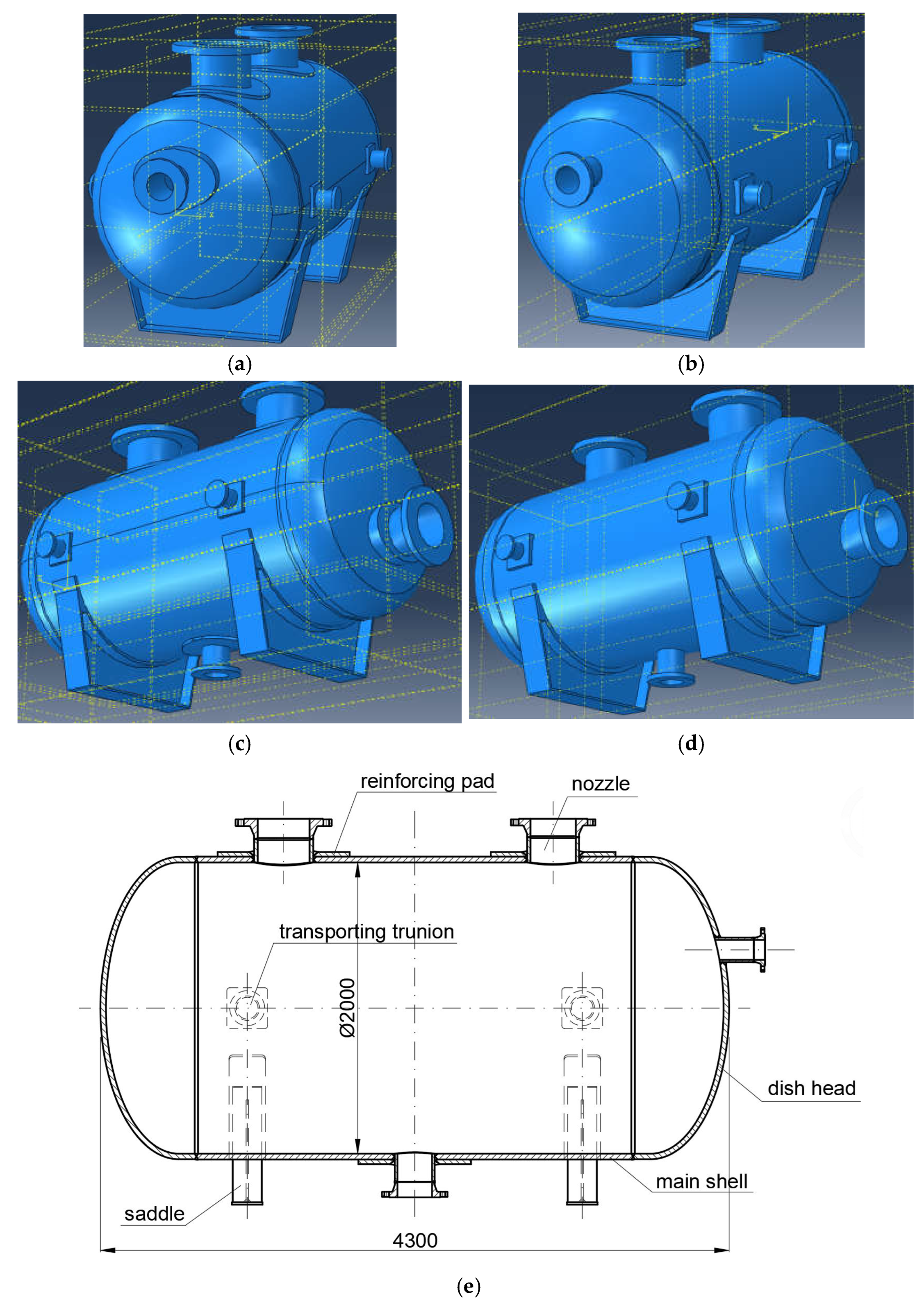
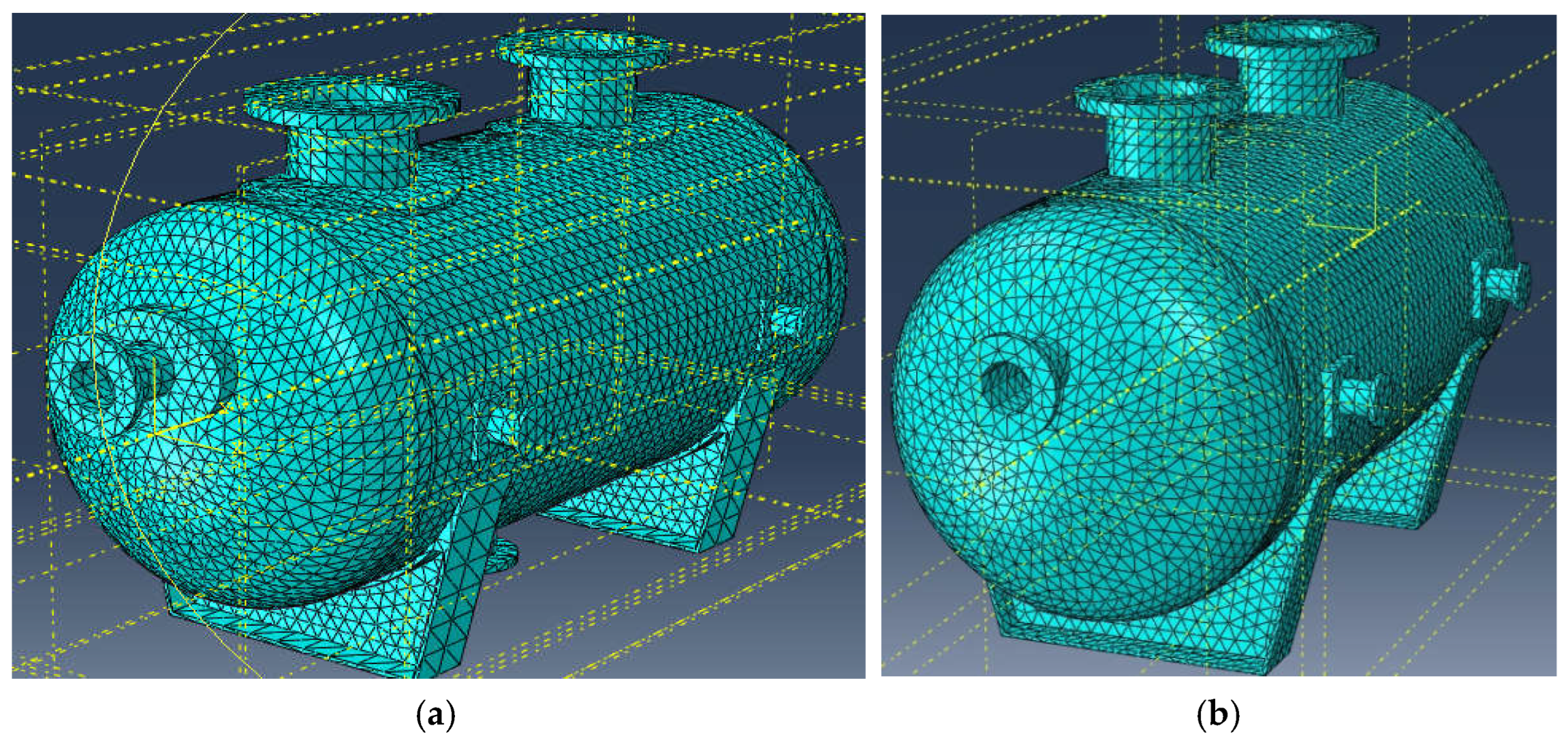
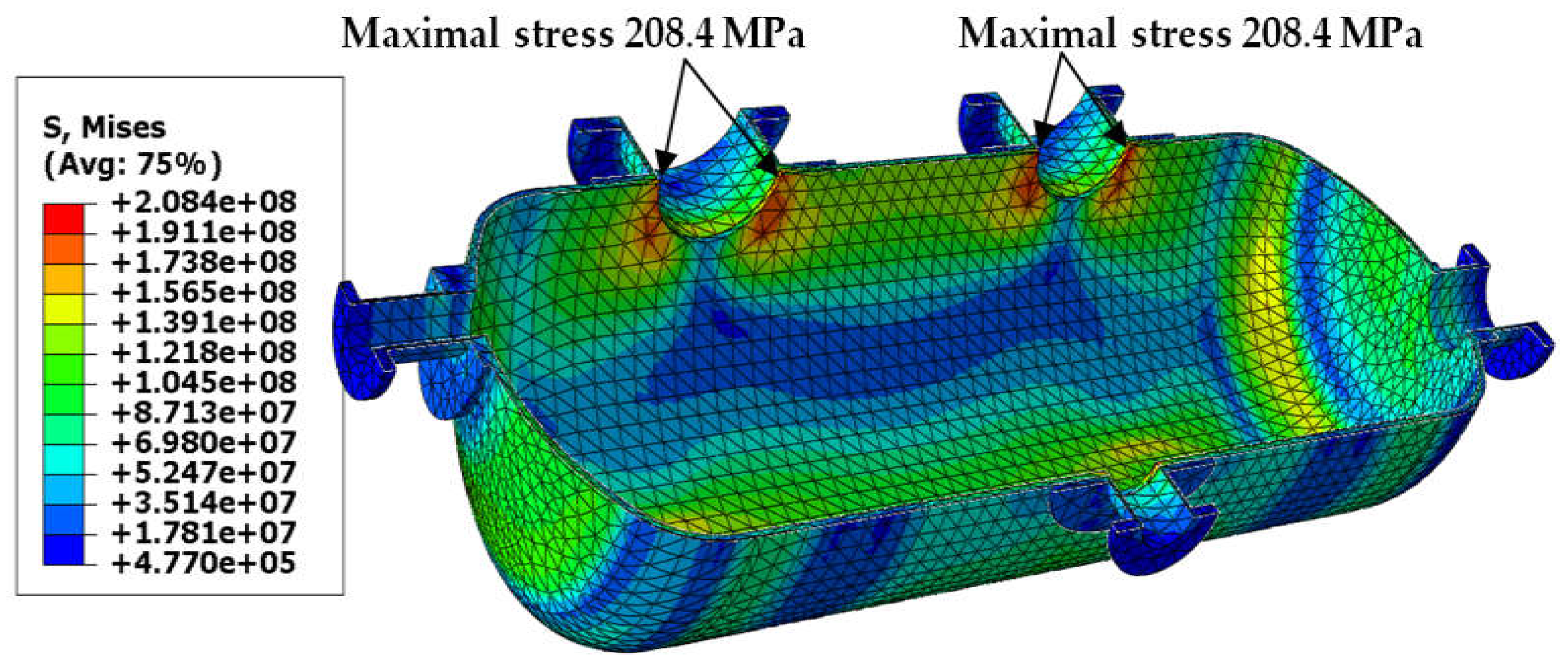


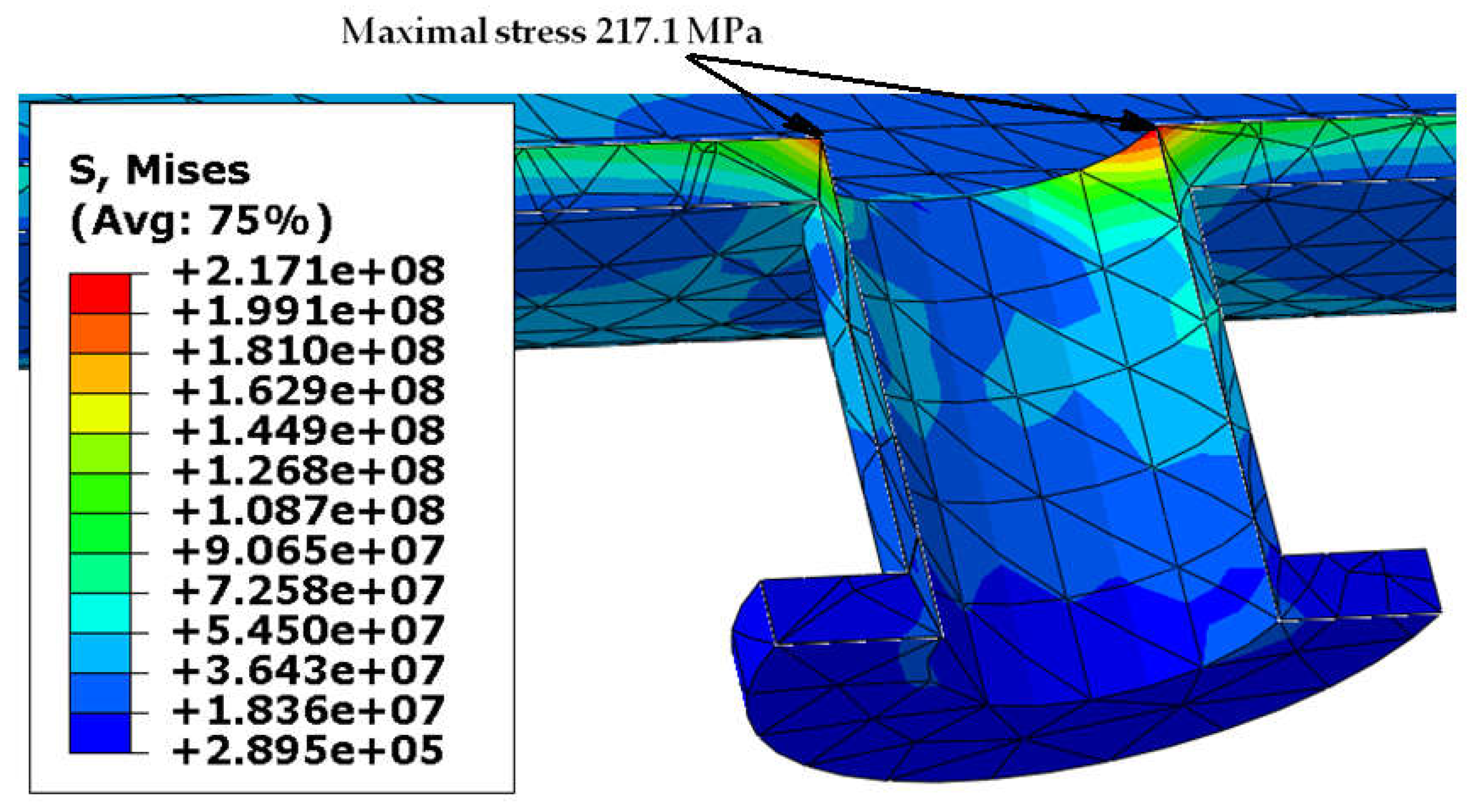
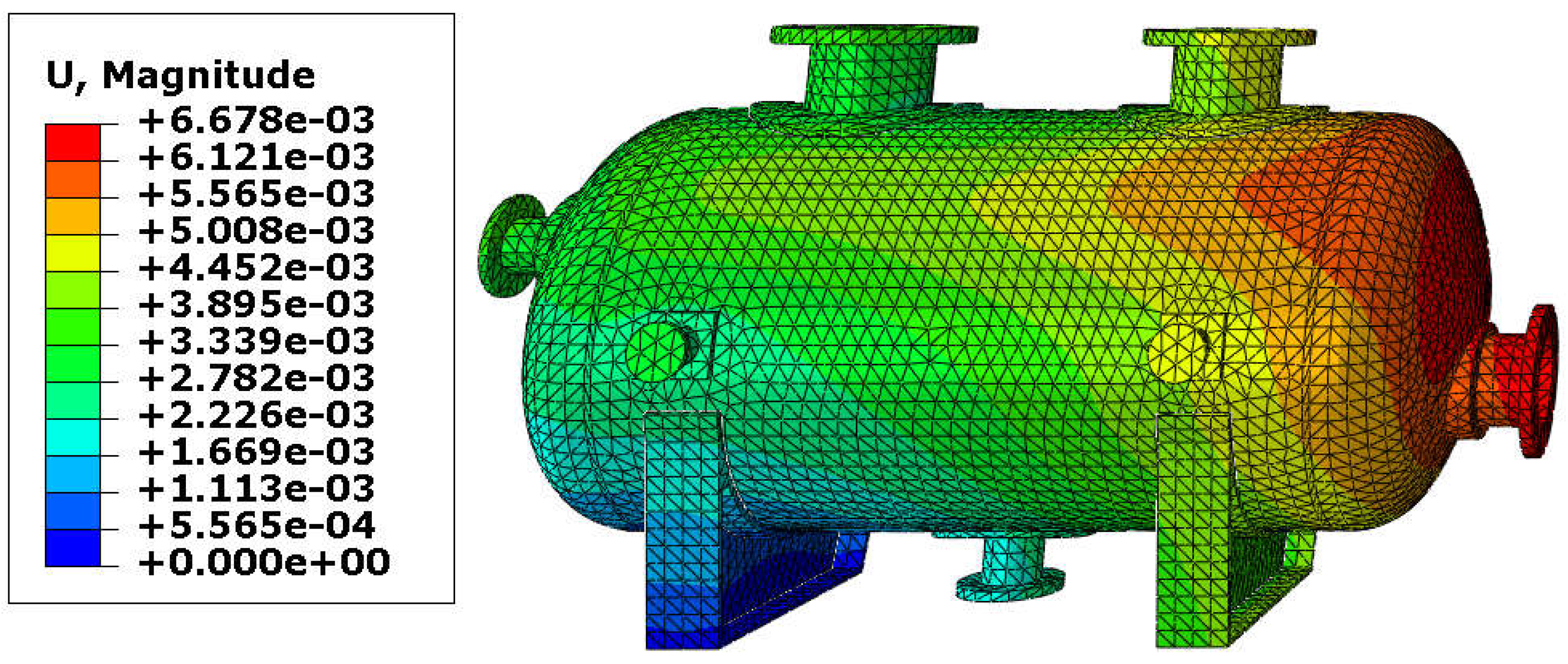
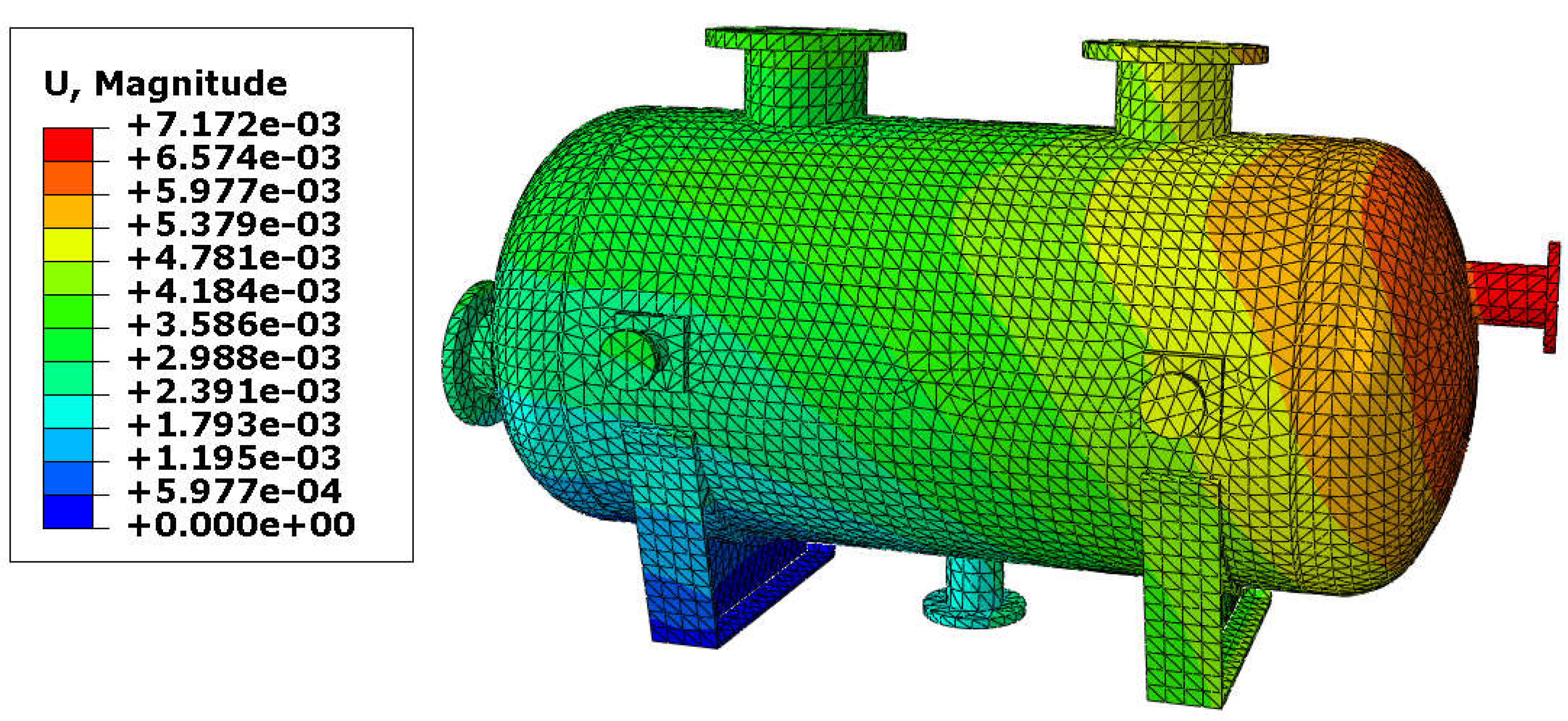
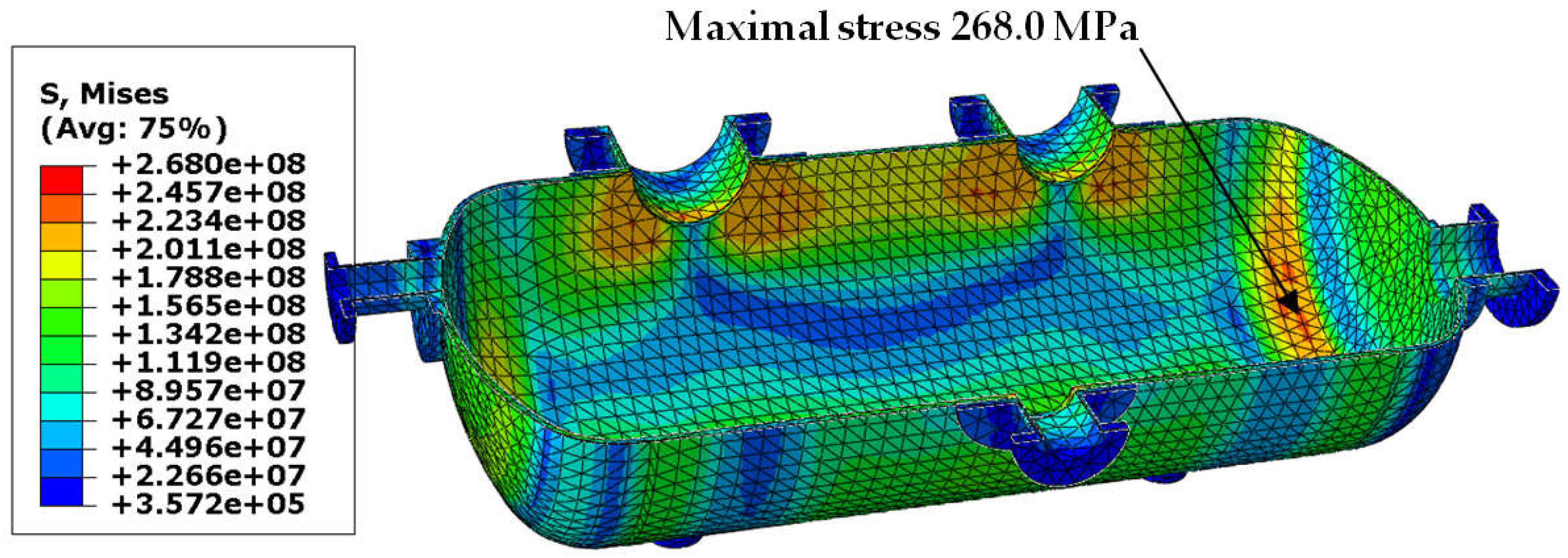

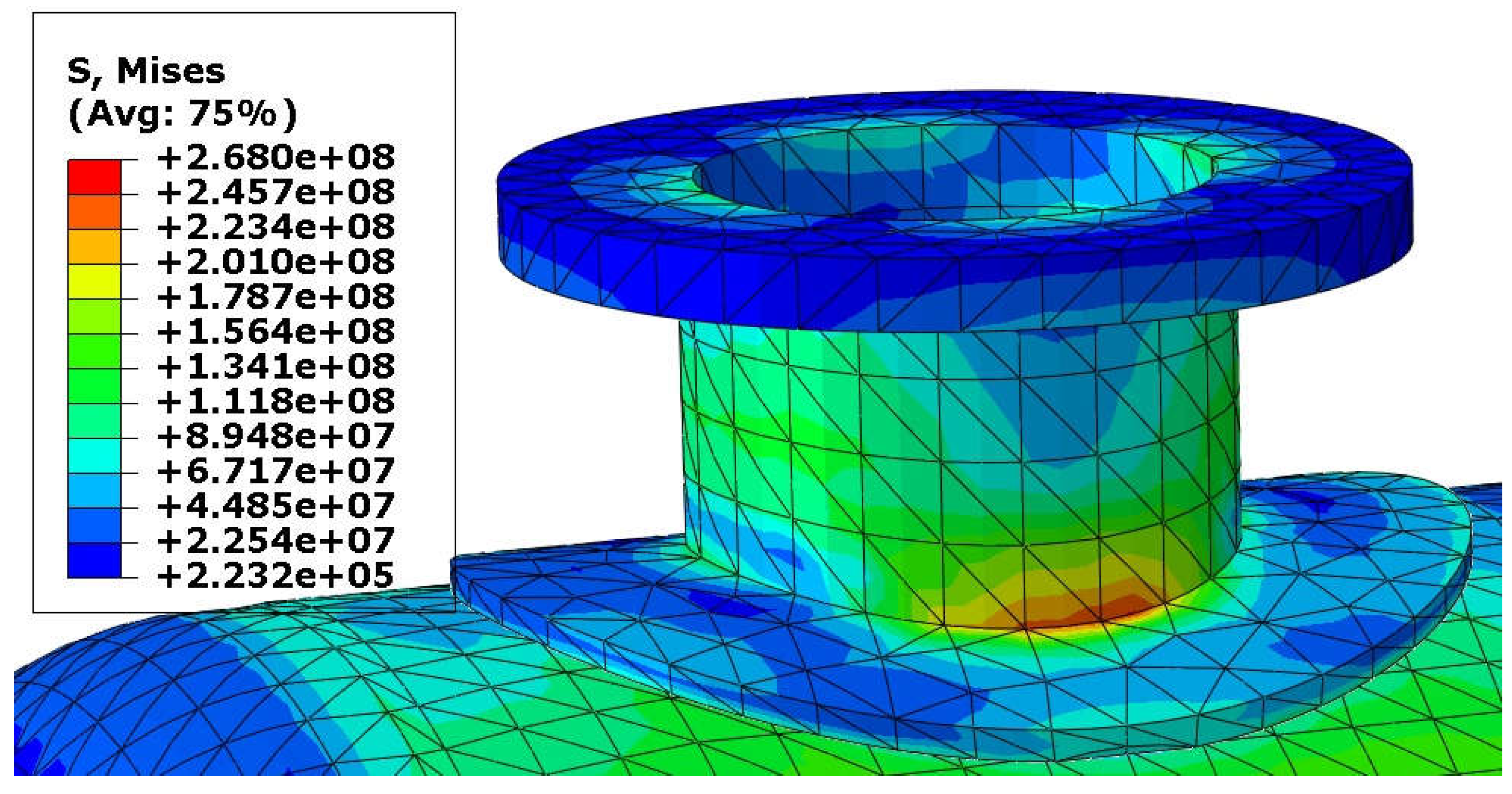
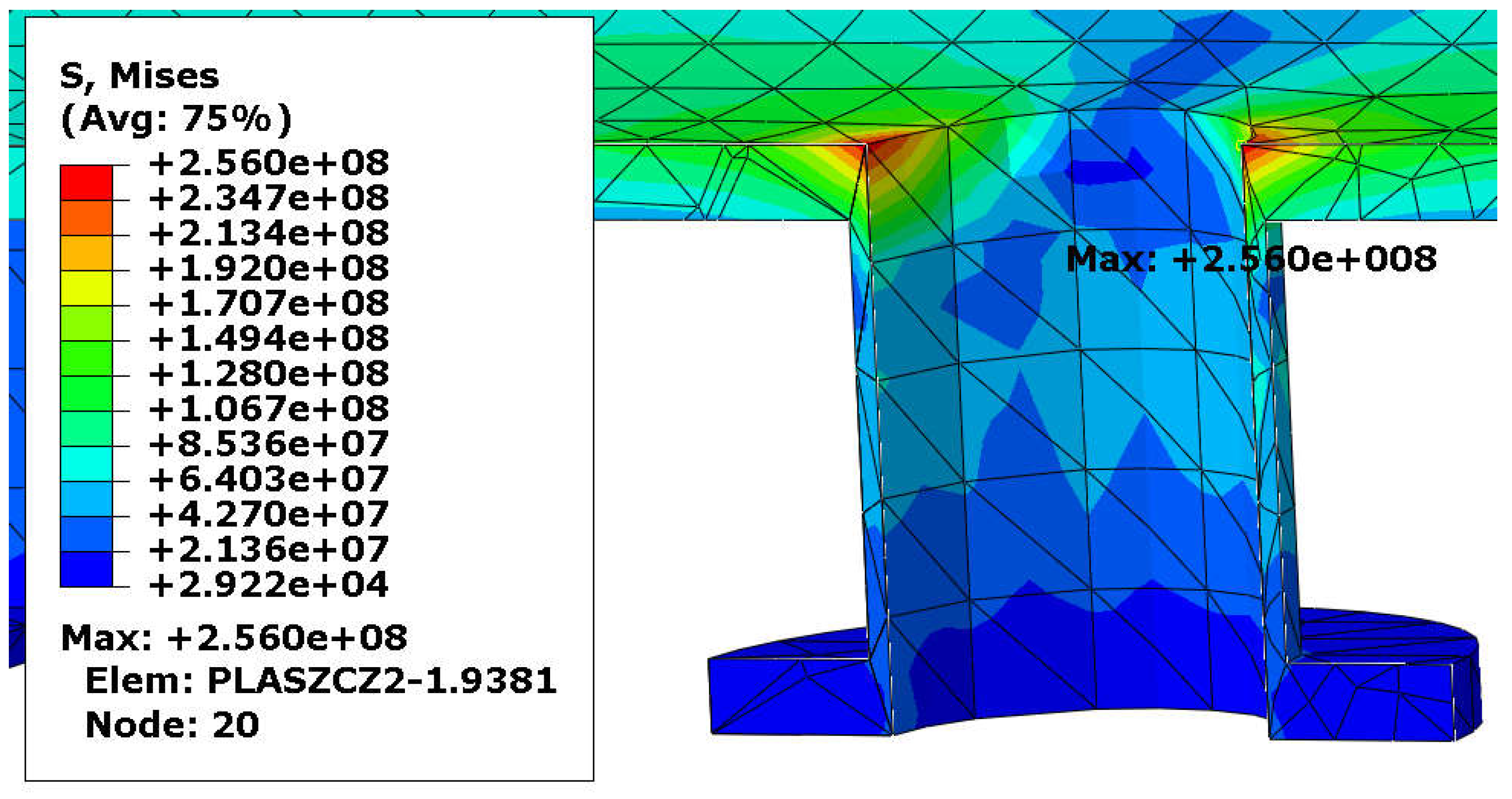
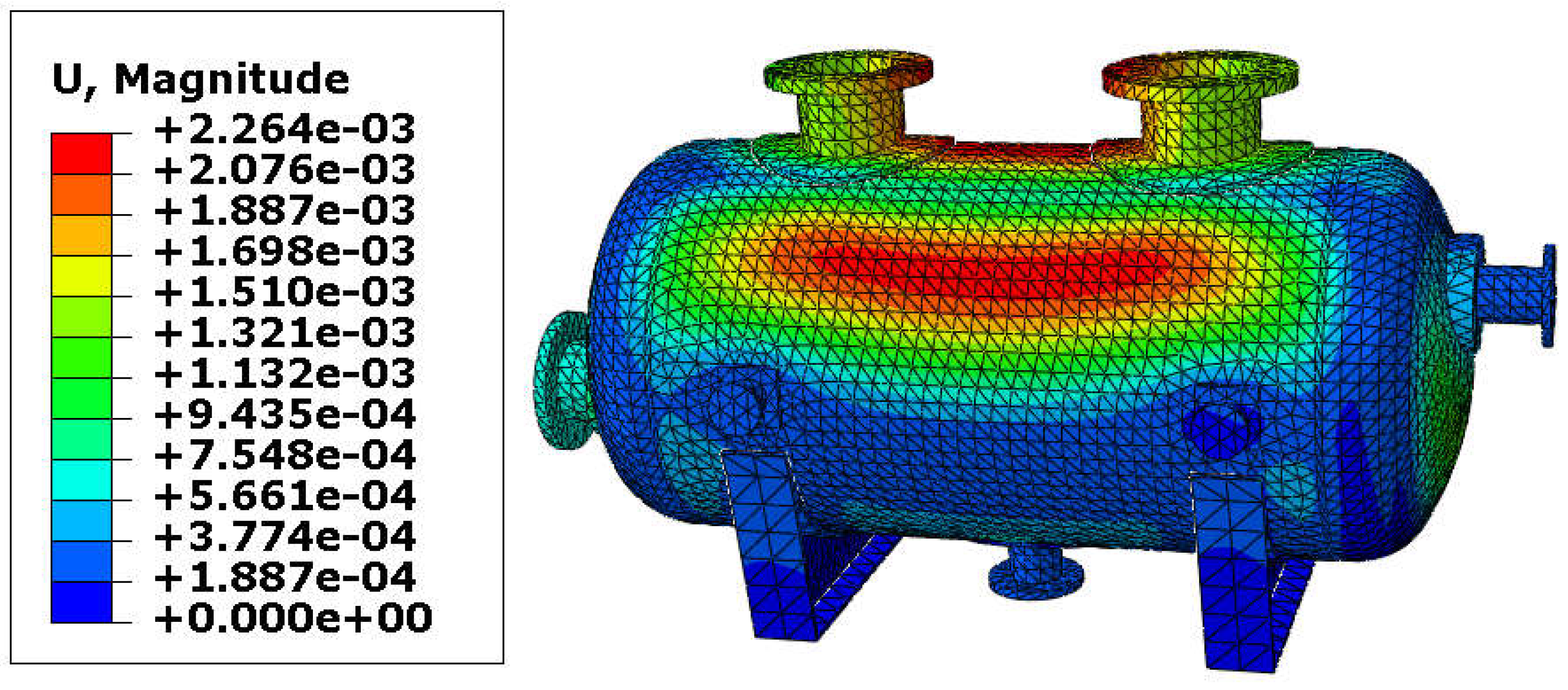
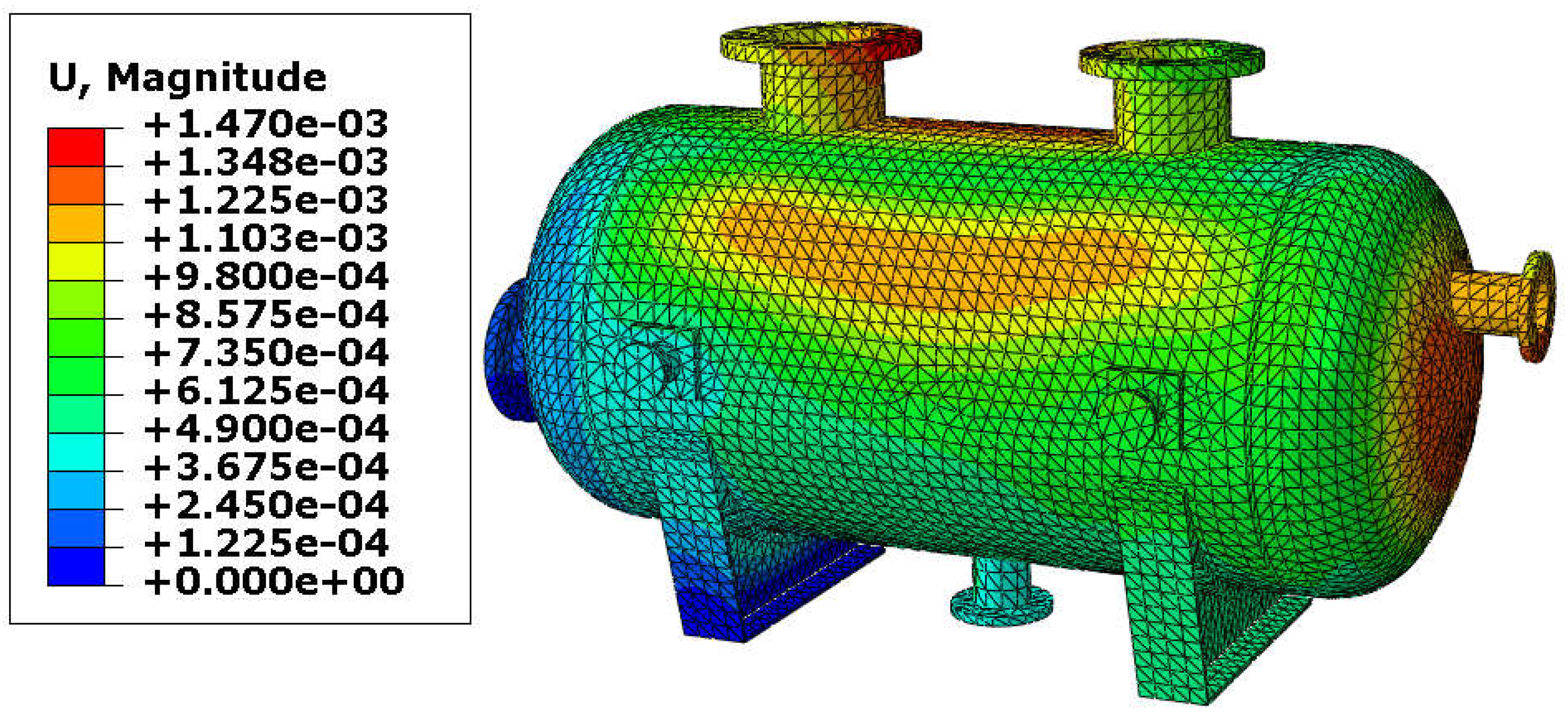
| Inner Diameter of Nozzle [mm] | Variant | Load Combination | Maximal Stress [MPa] | Tensile Strength [MPa] | Efficiency Ratio |
|---|---|---|---|---|---|
| 333.6 | with reinforcing pad | Case 1 | 301.2 | 410 | 0.735 |
| 303.9 | with reinforcing pad | Case 1 | 270.6 | 410 | 0.660 |
| 152.3 | with reinforcing pad | Case 1 | 133.5 | 410 | 0.326 |
| 333.6 | without pad | Case 1 | 199.9 | 410 | 0.488 |
| 303.9 | without pad | Case 1 | 200.0 | 410 | 0.488 |
| 152.3 | without pad | Case 1 | 217.1 | 410 | 0.530 |
| 333.6 | with reinforcing pad | Case 2 | 268.0 | 500 | 0.536 |
| 303.9 | with reinforcing pad | Case 2 | 266.2 | 500 | 0.532 |
| 152.3 | with reinforcing pad | Case 2 | 179.4 | 500 | 0.359 |
| 333.6 | without pad | Case 2 | 245.7 | 500 | 0.491 |
| 303.9 | without pad | Case 2 | 243.1 | 500 | 0.486 |
| 152.3 | without pad | Case 2 | 256.0 | 500 | 0.512 |
Disclaimer/Publisher’s Note: The statements, opinions and data contained in all publications are solely those of the individual author(s) and contributor(s) and not of MDPI and/or the editor(s). MDPI and/or the editor(s) disclaim responsibility for any injury to people or property resulting from any ideas, methods, instructions or products referred to in the content. |
© 2025 by the authors. Licensee MDPI, Basel, Switzerland. This article is an open access article distributed under the terms and conditions of the Creative Commons Attribution (CC BY) license (https://creativecommons.org/licenses/by/4.0/).
Share and Cite
Świt, G.; Szczecina, M. Numerical Study of the Reinforcing Pads Geometry of Pressure Vessels. Materials 2025, 18, 2318. https://doi.org/10.3390/ma18102318
Świt G, Szczecina M. Numerical Study of the Reinforcing Pads Geometry of Pressure Vessels. Materials. 2025; 18(10):2318. https://doi.org/10.3390/ma18102318
Chicago/Turabian StyleŚwit, Grzegorz, and Michał Szczecina. 2025. "Numerical Study of the Reinforcing Pads Geometry of Pressure Vessels" Materials 18, no. 10: 2318. https://doi.org/10.3390/ma18102318
APA StyleŚwit, G., & Szczecina, M. (2025). Numerical Study of the Reinforcing Pads Geometry of Pressure Vessels. Materials, 18(10), 2318. https://doi.org/10.3390/ma18102318





